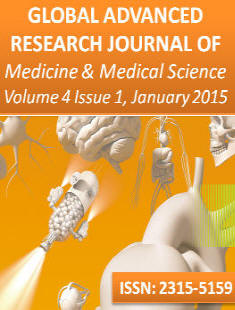|

January 2015 Vol. 4 Issue
1
Other viewing option
Abstract
•
Full
text
•Reprint
(PDF) (107 KB)
Search Pubmed for articles by:
Awoniyi AO
Olaniran O
Other links:
PubMed Citation
Related articles in PubMed
|
|
Global Advanced Research Journal
of Medicine and Medical Sciences (GARJMMS) ISSN: 2315-5159
January 2015 Vol. 4(1), pp.
057-060
Copyright © 2015 Global Advanced
Research Journals
Full Length Research Paper
|
Bacterial vaginosis
among pregnant women attending a primary health care
center in Ile-Ife, Nigeria
Awoniyi AO1,
Komolafe OI1*,
Bifarin O2,3 and Olaniran Olarinde4
1Department
of Obstetrics, Gynaecology, and Perinatology,
Obafemi Awolowo University, Ile-Ife, Osun State,
Nigeria
2Department
of Microbiology, Obafemi Awolowo University, Ile-Ife,
Nigeria
2Department
of Biology, the Catholic University of America,
Washington, DC 20064, USA
4Department
of Medical Microbiology and Parasitology, Obafemi
Awolowo University, Ile-Ife.
*Corresponding
Author E-mail:
daveskomolafe@yahoo.com; Phone: +234-8034812803
Accepted 12 January, 2015
|
|
Abstract |
|
Bacterial vaginosis (BV) is one of the most
prevalent vaginal infections among women in Africa.
In pregnancy, certain complications such as preterm
delivery, premature rupture of the membranes, and so
on could ensue from BV. This study investigated the
prevalence of BV among pregnant women attending
antenatal clinic in a primary health care center at
Enuwa, Ile-Ife, Nigeria and suggested possible
interventions to avoid BV-associated complications
in pregnancy. One-hundred and fifty high vaginal
samples were collected from pregnant women having
vaginal discharge and within the age range 20-40
years. The samples were collected and processed
following Amsel criteria and Nugent criteria.
Statistical analysis was based on simple percentages
among related variables. Fifty pregnant women
(33.3%) were identified for BV with Amsel criteria
while ninety pregnant women (60%) were identified by
Nugent criteria. Bacterial vaginosis was more
prevalent among pregnant women in first trimester
(36.7%), primigravidae (33.3%), and age group 20 to
25 years (38.9%). Consequently, high rate of BV
among pregnant women attending PHC clinics demands
adequate attention to prevent BV-associated
complications in pregnancy and also reduce referrals
that may ensue from such complications. Pregnant
women attending antenatal clinic in various PHCs
should be screened routinely for BV to avoid
infection sequelae. Adequate laboratory facilities
should be provided and laboratory personnel should
be trained in the use of Nugent criteria for
effective diagnosis of BV since the method is
convenient and reliable. This will aid prompt and
adequate diagnosis of BV in pregnancy. Effort should
be made to discourage promiscuity among
sexually-active age group and
self-diagnosis/medication among pregnant women.
Keywords:
Bacteriavaginosis, Primary Health Care,
Gardnerella vaginalis, Pregnant women, Antenatal
clinics, Prevalence
|
| |
|
